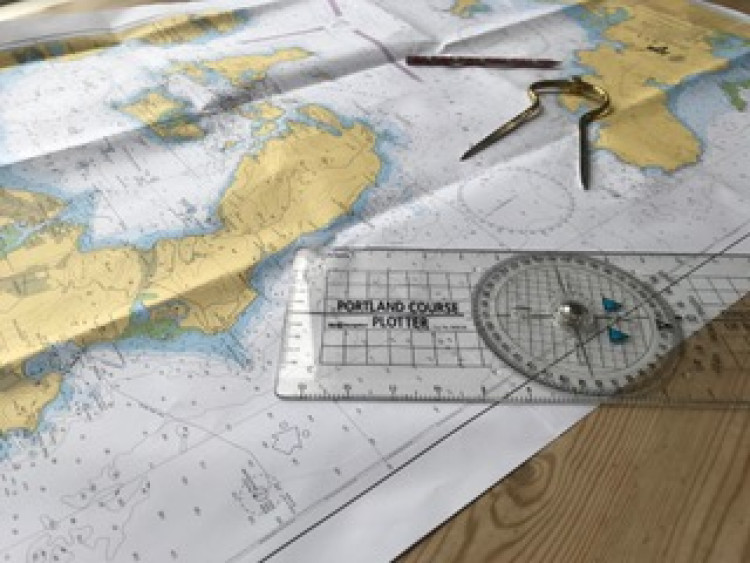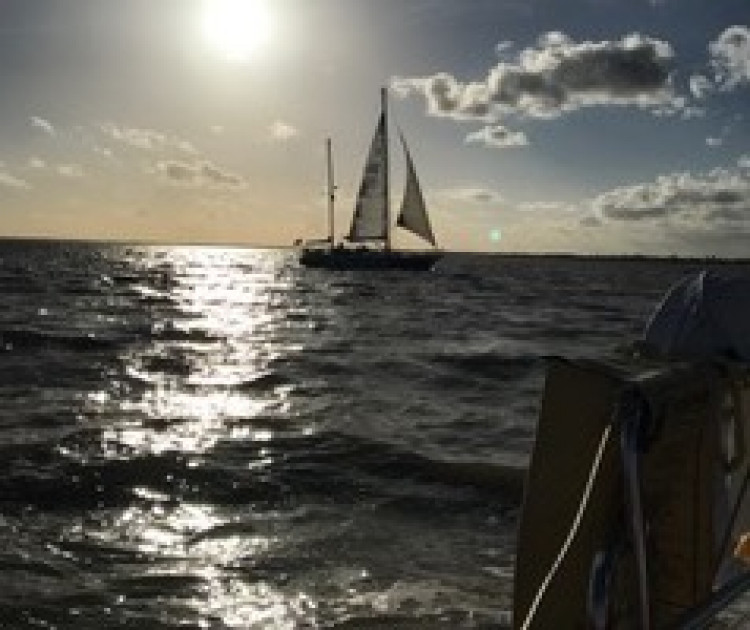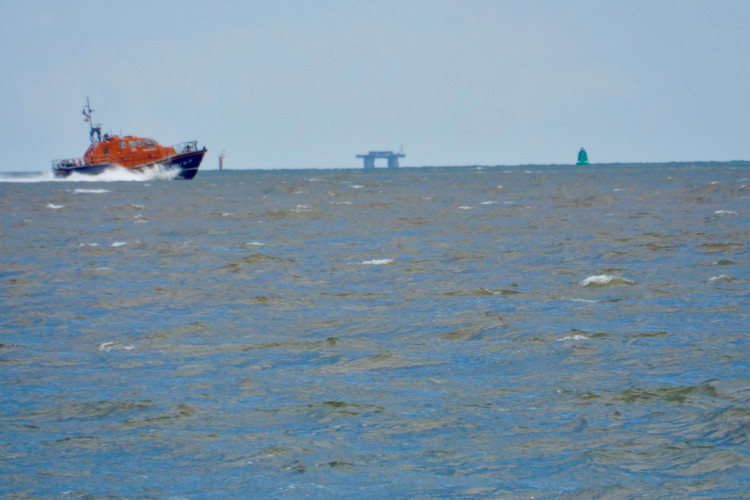A View from the Stour - Five Days a Skipper
By Derek Davis 10th Nov 2022
By Derek Davis 10th Nov 2022

Travel writer Sophie Holloway gives a first hand account of what it takes to be a Day Skipper sailing from the Felixstowe peninsula the Stour and Orwell rivers, and beyond
A peninsula is defined by the water that surrounds it; in Latin it literally translates as 'almost island'.
Having spent the best part of 15 years living on the peninsula, views of the Orwell and the Stour – in all seasons and moods – are very familiar to me. They are my childhood landscapes. It can feel strange, then, to suddenly flip your perspective on the world you know so well – and this is exactly what I did when I took to the rivers last week.
Enrolling on my Day Skipper course a month before and learning the necessary theory beforehand, last month I set off to Suffolk Yacht Harbour at Levington to meet the people I would be living on board with for a week. After a quick pint in the red lightship – the harbour's iconic clubhouse – we settled down in our cabins and bedded down for the evening.

Some industrial earmuffs might have been useful that night, with the creaking of fenders and loose lines heavily amplified in the aft cabins – my cabin.
A quick breakfast of toast and tea, and then we were off. First of all, tacking practice – that is, turning the boat into and through the wind in order to change direction.
Before long, we were at Harwich harbour, the faint smell of fish and chips wafting across the deck as we inched closer in a 'pontoon-bashing' exercise, essentially the parallel parking of the boating world.
After a quick but essential visit to Harwich's well-renowned chippy, 'Pieseas', we were back on board, preparing for perhaps the most important drill of all – man overboard, or MOB for short.

Techniques tend to vary, but when a crew member – or heaven forbid, the skipper – goes overboard, this is no time to be dogmatic about it. If there is one rule common to all, it is to never let that person out of your sight. It seems basic, but it is surprising how quickly and easily you can lose track of a casualty in the water.
With the nights drawing in, it was not long before we had to head back to the marina. After a warming lasagne, another mug of tea and a de-brief, by ten we were in our cabins once again, bracing ourselves for a sleepless night.
Whilst we did get more sleep than anticipated, the weather forecast the following morning was not looking good. We took our chances nevertheless and managed a few hours of sailing before we were caught out mid-morning in a heavy rainstorm and had to promptly return to Levington marina, wasting no time with a spot of theory consolidation over lunch. Types of buoys and light sequences were the main focus – a subject that requires a lot of swatting, but is absolutely essential knowledge, as we would find out later that week.
By day three of the trip, it was time for some applied theory – pilotage plans. This involves creating a detailed route you intend to follow from A to B, including the type of buoys you will pass, the danger zones and any anchorage spots, among other things. Of course, it is always important to factor in what the tide and wind are doing in any case, to avoid running aground or finding yourself in a tight spot, to put it mildly.

It is very easy to rely on GPS, but there is a great satisfaction in not having to rely on it. And moreover, GPS is not always 100% reliable, so it is best to use it in tandem with a paper chart and pencil plan – old school always wins! Knowing where you are at all times on the water – without electronic aid – is a fundamental part of the Day Skipper course.
As we sailed slowly into Hamford Water, small shiny black buoys began to emerge and re-emerge in different places. As we got closer however, and our eyesight collectively improved, we realised our mistake. Playful seals hugged the marshes, watching with curiosity, and perhaps amusement, as a couple of us wrestled awkwardly with a jammed anchor. Another important part of the Day Skipper course is knowing how to handle the boat when people are watching you, so this was a perfect trial run.
That evening, we prepared the boat for a night trip, which involves setting up the correct navigation lights. For a sailing boat under motor, the lights are a white masthead light and stern light, and a bicolour light too (green for starboard, red for port). At night, different boats under different conditions will show different light combinations – and knowing this is crucial.

And as we set out into the busy shipping channel, with Felixstowe port glowing and groaning in its relentless activity, we realised just how crucial. Buoys mark the channel, danger zones or directions, and they do so by colour and flashing sequence. A mix-up can be very problematic, if not fatal. With one person in the galley, consulting the GPS and passing on this information, we made it safely out to sea and back again, under the watchful eye of our instructor.
Day five now and we are close to finishing the course. A trip to Sealand was our final major outing, a historic landmark located about seven nautical miles south-east of Felixstowe. Originally built as a defence fortress against the Germans in WWII, Rought Towers (later christened 'Sealand') was abandoned in the 50s. Because it lay out of territorial range (three nautical miles), it was soon claimed by a former British major, Roy Bates, and his wife, Joan, who dubiously declared Sealand's sovereignty in 1967, not without resistance from the British government.

Later down the line, in 1978, Roy's son Michael was kidnapped by German and Dutch mercenaries. But their attempt to claim Sealand for their own was quickly curtailed, since Michael was able to retaliate with weapons stashed in the platform below. More recently, in 1999, Michael, established an internet server (HavenCo) on Sealand which was free from the usual restrictions, with the help of a team of twenty-five UK, US and European nationals. But this enterprise later collapsed and now Sealand is no more than a peaceful, popular attraction for many sailors.
Getting to Sealand involved plotting a course to steer – that is, finding the correct bearing to head for by accounting for tidal streams and wind direction and strength in your calculations. It is always best to prepare any calculations in advance, as I found out too late, since doing it whilst at sea and below deck usually results in some unpleasant bouts of seasickness and no doubt some major inaccuracies. A few degrees off can cost you miles!
Back to Ipswich Haven Marina for the night. The following morning was spent honing our manoeuvring skills in the harbour and on our final trip back to Levington marina, we treated ourselves to some bacon sandwiches, prepared at a 45-degree angle. And of course, more tea.
I had a brilliant time on this course. I would highly recommend it to anyone interested in developing not only their sailing skills, but also their confidence in marine navigation and most importantly, learning how to take charge of a vessel. Knowing how to do anything well on your own is one thing; but knowing how to get others to do something well is another. I certainly have not mastered the art of giving instructions on a boat, but this course has inspired me to find more opportunities – and there are lots out there – to become the best skipper I possibly can.
Sophie's Website: mercurysfootsteps.wordpress.com
CHECK OUT OUR Jobs Section HERE!
felixstowe vacancies updated hourly!
Click here to see more: felixstowe jobs
Share:


